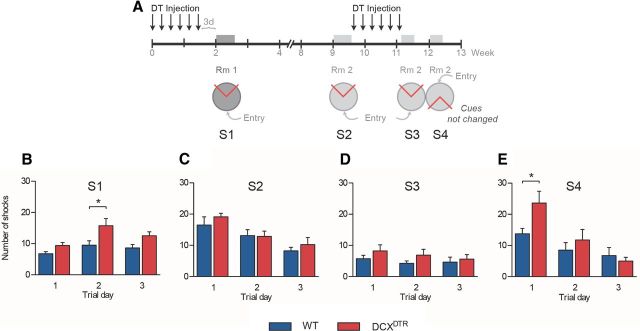Figure 6.
Repeated depletion of immature neurons in the DCXDTR transgenic mouse model impairs reversal learning in the active place avoidance task. A, Experimental design used to test acquisition deficits (S1), recovery (S2), recall (S3), and reversal learning (S4) after multiple rounds of DT-induced DCX+ cell ablation. B, DCXDTR mice received a greater number of shocks when tested in the active place avoidance task after initial depletion of the immature neurons (F(1,14) = 11.28, p < 0.01). C, This deficit was rescued after a rest period during which time the immature neurons repopulated the dentate gyrus in either genotype (F(1,14) = 0.68, p = 0.42). D, The second depletion did not produce a deficit when animals were retested in the already familiar task (F(1,14) = 1.70, p = 0.21). E, When presented with a reversal of location of the shock and entry zones, DCXDTR mice were slower than WT mice in adjusting their behavior to avoid the shock zone, with two-way ANOVA showing an interaction between genotype and time (F(2,14) = 3.28, p = 0.05). S indicates experimental session (i.e., S1, Session 1). *p < 0.05, Significance between genotypes for individual trial days (Bonferroni post hoc test). n = 8 per experimental group.

